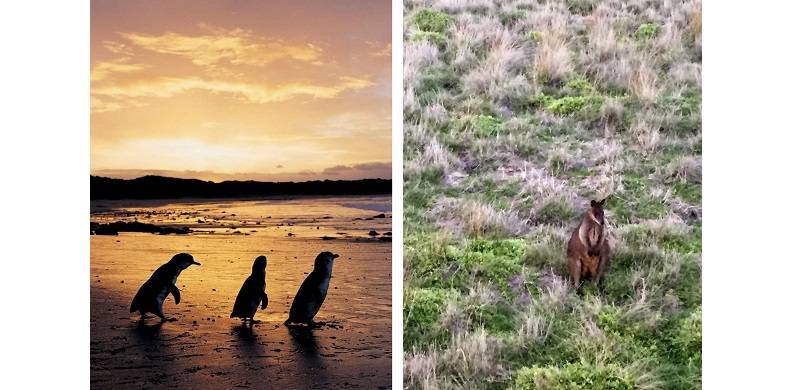
While touring the urban delights of Melbourne, we discovered that there was a place called Phillip Island, which was worth visiting to catch a sight of the penguins. The birds would put on a ‘parade' an hour after sunset, by wading ashore and scurrying toward their boroughs.
Our ride on a double-decker tour bus was bland until we got closer to the water. The scenery felt eerie: hilly, grassy, and devoid of human presence.
As we got closer to the sea, fishing villages sprung into view. They had a desolate quality, evoking the scenery of the Russian village in the film Leviathan, which I had made the mistake of seeing on the 787 Dreamliner that had brought us here from California. That film was pregnant with foreboding. It had knocked out all my dreams about visiting Russia! On the bus, I found myself saying over and over again that this was Australia and not Russia. No gruesome fate awaited us. We had done nothing to anger the gods. Dostoyevsky had not written the script for this tour and neither had Shakespeare. There was no reason to remember Gloucester’s lines from King Lear: “As flies to wanton boys are we to th' gods. They kill us for their sport.”
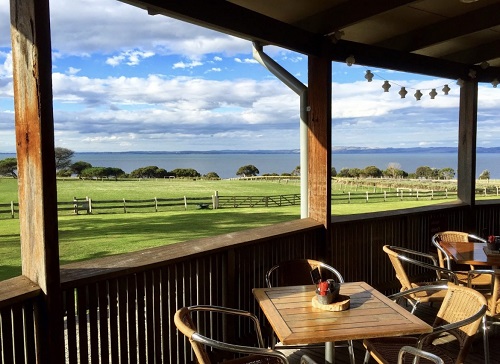 We stopped for afternoon tea at Churchill Island. Ah, the Last Lion had been everywhere, not just in Sudan, South Africa, Afghanistan, Swat or Egypt. Alternatively, perhaps, was it just named after him, like the state of Victoria was named after the Queen and so was the state of Queensland? They could not have enough of British royalty down under, it seemed.
We stopped for afternoon tea at Churchill Island. Ah, the Last Lion had been everywhere, not just in Sudan, South Africa, Afghanistan, Swat or Egypt. Alternatively, perhaps, was it just named after him, like the state of Victoria was named after the Queen and so was the state of Queensland? They could not have enough of British royalty down under, it seemed.
The lodge where we had tea was charming with stunning views of the sea.
Later, as we walked around the island, we saw a sheep being sheared (not recommended). It reminded me of the scene that I had encountered in 11th grade at Adamjee Science College while reading Thomas Hardy’s classic novel Far from the Madding Crowd. The poor creature was being held upside down and being administered a rather nasty haircut with dozens of Indonesian (or perhaps Malaysian?) tourists watching, the women with their hair tightly covered.
The next stop on the bus tour was a place for viewing the koalas.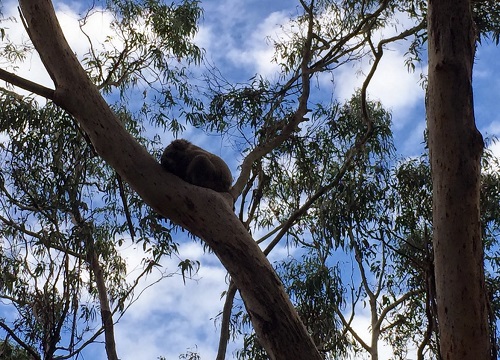
While walking along the strategically placed boardwalks, we spotted a couple of koalas, soundly asleep on tree branches. The guide informed us that they slept for 20 hours and in the other four hours they munched on the leaves of Eucalyptus trees. That only gives them limited energy – equal to a bowl of cereal, and even that energy was burned off in the process of chewing. The whole process left them tired and they dozed off to sleep.
What an interesting life, indeed! We were told not to disturb them. But one man in our group was unable to restrain himself. On spotting a sleeping koala, he started making weird sounds and faces. He had to be shouted down by the rest of us. It was quite a ruckus. Somehow, he thought I was the instigator and began to look in my direction with a steady gaze. I walked away, somewhat unsteadied by his fury.
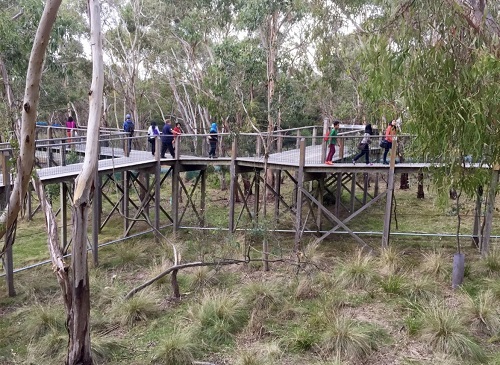 Now the drive became really interesting, as we approached the tip of the island, where the penguins waded ashore from the sea. It reminded me of Scotland. But the sun had not gone down, so the bus driver decided to give us a bonus tour of the windswept moors that occupied this portion of the island. We spotted first one, then two and then countless wallabies. They were like mini kangaroos frolicking in the open space. One posed beside the double-decker bus.
Now the drive became really interesting, as we approached the tip of the island, where the penguins waded ashore from the sea. It reminded me of Scotland. But the sun had not gone down, so the bus driver decided to give us a bonus tour of the windswept moors that occupied this portion of the island. We spotted first one, then two and then countless wallabies. They were like mini kangaroos frolicking in the open space. One posed beside the double-decker bus.
The cameras clicked away. The driver, a loquacious woman, gave us the tour to remember as she navigated the Leviathan of a bus through winding and descending roads. We were headed for the beach where the rendezvous with the penguins was going to occur. We were in the upper deck, in seats 33 and 34. But the vertigo reflex had been activated. I closed my eyes and the lovely views disappeared.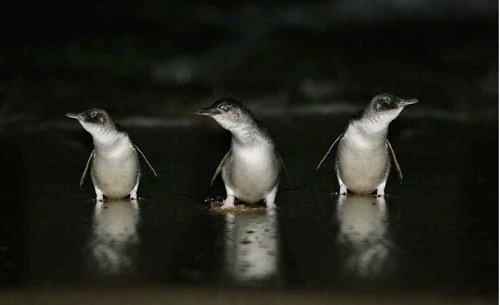
Finally, we had arrived at the viewing area for the penguins. The sun had gone down and darkness was spreading, reminding me of the lines from a poem by T. S. Eliot: “Let us go then, you and I, when the evening is spread out against the sky. Like a patient etherised upon a table.”
Our VIP passes (appropriately expensive) entitled us to a half-hour lecture from a marine biologist. She lectured without making eye contact and that put me off. But her knowledge came through during the questions and answers session that followed, assuring me that this would be a worthwhile excursion to the sea. Most of the questions came from me, perhaps to the annoyance of others. But what was I to do with my curiosity? Should I shut it down simply because the others were not curious?
We were happily sipping tea and munching on crackers when the biologist passed around a stuffed penguin. It was a bit alarming. We were told how penguins spend their lives. 50% never made it to the sea and died young. Of the ones that did make it to the sea, only 20% came back. The others died of starvation. Nobody was there to teach them how to fish. They had to dive more than 200 times a day to catch fish. The ones who died were not washed ashore. They were consumed by other creatures. The average life span was some 25 years. The consumption of tea and crackers had stopped. Our appetites were missing in action.
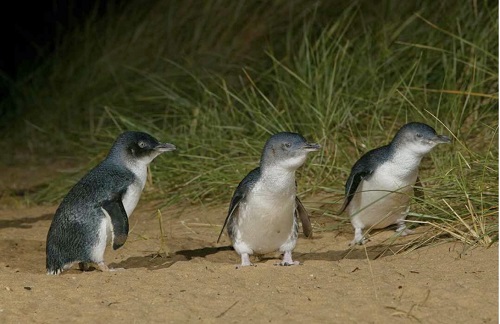 A young Indian woman was emotionally aroused. She asked if anything could be done to prolong the lives of the penguins. The biologist said that the penguins were wild creatures and we were not supposed to interfere with nature.
A young Indian woman was emotionally aroused. She asked if anything could be done to prolong the lives of the penguins. The biologist said that the penguins were wild creatures and we were not supposed to interfere with nature.
With that answer, she began to walk us over to our viewing hut on the beach. We were provided binoculars and chairs. There was a ranger inside, but he seemed totally un-amenable to conversation. He said his job was to count the penguins. I said: “How do you count them?” He said: “1, 2, 3 and …” I asked: “Is it computerised?” He said: “No, I just count them manually, like man has been doing over the ages. I was impressed. The man was also a historian. So, I asked, “How many do you count in a day? He said, “As few as 9 and as many as 2,000.” Wow! That was quite a range. Then came the unavoidable question: “So, is it about a thousand on a typical evening?” He said, “Something like that.”
I would never survive in such a job.
Outside of the hut were Roman amphitheater-like cement seats and they were all occupied by people covered from head to toe in blankets and hats. A brisk wind began to blow. We had encountered a rain shower enroute to the island. I suspected the seats were wet and uncomfortable all around. But the crowd sat there stoically, in anticipation of the parade which admittedly was not going to have a Roman character to it.
The moon was nearly full and playing peek-a-boo with the clouds. I asked the marine biologist if the presence of the moon altered the behaviour of the penguins. Perhaps I was recalling a scene from some film. She said, no, but if it was very bright, they would come ashore a bit later. She also added, with a touch of Aussie humour, “They do not wear watches.”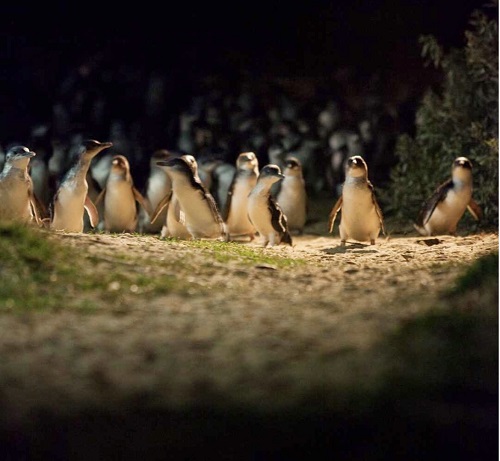
We waited and waited. Nothing happened. I wondered if none would turn up tonight. Then a cheer went up. A little penguin had appeared: all ten inches of it. Just like the one we had seen during the lecture. These were tiny creatures; much smaller than the ones you would see near the South Pole. Those were ice water penguins. These were warm water penguins.
Then two more appeared, and then there were ten: standing there, just at the edge of the beach, hesitant to take the next step. I assumed they were quite wet. After some hesitation they began to cross the beach. Photography was verboten. We had been told numerous times on the bus. That realisation nearly killed me. We were told that in the past, the crowds had used flash on the penguins and upset them. Some had rushed back into the sea. Some had become disoriented and thrown up. Some had died. So, no pictures, please. With or without flash. Thankfully some pictures are posted in the galleries section.
Now more were coming out, in batches of fives and tens. It was quite the sight. It was the crowning achievement of the evening. The show was at its climax.
The ranger took us out of the hut and walked us toward a boardwalk with a viewing platform that overlooked the show that the penguins were putting on, under a quasi-full moon whose light had now lit up the entire sea in a brilliant silver colour. The little penguins were scurrying past us in groups of tens. I asked if there was a leadership pattern of any kind among the birds and was told ‘no.’
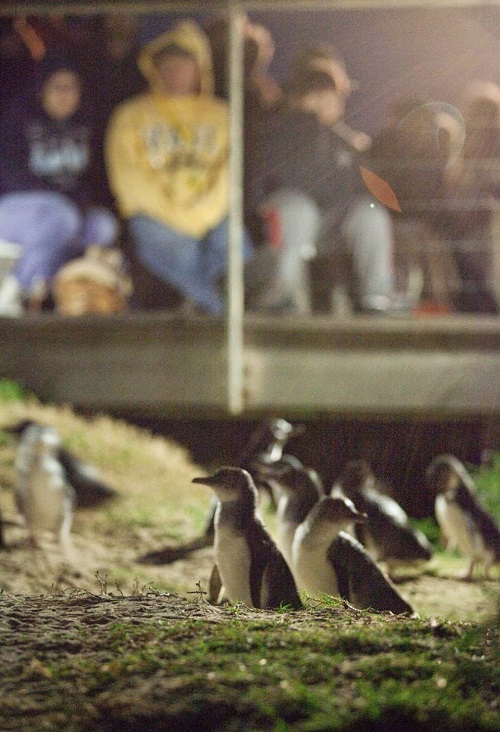 At some point they just stopped coming. We were told that 90% of them come ashore at different places on the island. It was time to go home.
At some point they just stopped coming. We were told that 90% of them come ashore at different places on the island. It was time to go home.
I spotted another ranger and asked him if he could point out the Southern Cross to me. And so he did. He was an astronomy buff. By the time we left, he had pointed out Alpha-Centauri to me, which he said was the star closest to us other than the sun; the planet Jupiter, which was the brightest object in the sky after the moon; and Sirius, the brightest star. We also talked about how long it took to fly to Australia from California and how difficult it was to sleep on those long flights. The only thing I forgot to discuss with him was whether he had seen the film Interstellar.
But it was time to catch the bus and head home. We climbed aboard the bus, ready to fall asleep. But the bus driver apparently thought we had not had enough of penguins. She put on a movie, Surf’s Up, which was centered on a penguin called Cody. There was no way to turn off the volume. I began to watch it. It was amazing. In the end, I was happy that I had seen it.
When I got back from my trip, and unpacked my luggage, I discovered that I had brought along with me a Sunday issue of The Age, an Australian paper.
Coincidentally, it contained an article on the penguins of Phillip Island.
Our ride on a double-decker tour bus was bland until we got closer to the water. The scenery felt eerie: hilly, grassy, and devoid of human presence.
As we got closer to the sea, fishing villages sprung into view. They had a desolate quality, evoking the scenery of the Russian village in the film Leviathan, which I had made the mistake of seeing on the 787 Dreamliner that had brought us here from California. That film was pregnant with foreboding. It had knocked out all my dreams about visiting Russia! On the bus, I found myself saying over and over again that this was Australia and not Russia. No gruesome fate awaited us. We had done nothing to anger the gods. Dostoyevsky had not written the script for this tour and neither had Shakespeare. There was no reason to remember Gloucester’s lines from King Lear: “As flies to wanton boys are we to th' gods. They kill us for their sport.”
 We stopped for afternoon tea at Churchill Island. Ah, the Last Lion had been everywhere, not just in Sudan, South Africa, Afghanistan, Swat or Egypt. Alternatively, perhaps, was it just named after him, like the state of Victoria was named after the Queen and so was the state of Queensland? They could not have enough of British royalty down under, it seemed.
We stopped for afternoon tea at Churchill Island. Ah, the Last Lion had been everywhere, not just in Sudan, South Africa, Afghanistan, Swat or Egypt. Alternatively, perhaps, was it just named after him, like the state of Victoria was named after the Queen and so was the state of Queensland? They could not have enough of British royalty down under, it seemed.The lodge where we had tea was charming with stunning views of the sea.
Later, as we walked around the island, we saw a sheep being sheared (not recommended). It reminded me of the scene that I had encountered in 11th grade at Adamjee Science College while reading Thomas Hardy’s classic novel Far from the Madding Crowd. The poor creature was being held upside down and being administered a rather nasty haircut with dozens of Indonesian (or perhaps Malaysian?) tourists watching, the women with their hair tightly covered.
The next stop on the bus tour was a place for viewing the koalas.

While walking along the strategically placed boardwalks, we spotted a couple of koalas, soundly asleep on tree branches. The guide informed us that they slept for 20 hours and in the other four hours they munched on the leaves of Eucalyptus trees. That only gives them limited energy – equal to a bowl of cereal, and even that energy was burned off in the process of chewing. The whole process left them tired and they dozed off to sleep.
What an interesting life, indeed! We were told not to disturb them. But one man in our group was unable to restrain himself. On spotting a sleeping koala, he started making weird sounds and faces. He had to be shouted down by the rest of us. It was quite a ruckus. Somehow, he thought I was the instigator and began to look in my direction with a steady gaze. I walked away, somewhat unsteadied by his fury.
 Now the drive became really interesting, as we approached the tip of the island, where the penguins waded ashore from the sea. It reminded me of Scotland. But the sun had not gone down, so the bus driver decided to give us a bonus tour of the windswept moors that occupied this portion of the island. We spotted first one, then two and then countless wallabies. They were like mini kangaroos frolicking in the open space. One posed beside the double-decker bus.
Now the drive became really interesting, as we approached the tip of the island, where the penguins waded ashore from the sea. It reminded me of Scotland. But the sun had not gone down, so the bus driver decided to give us a bonus tour of the windswept moors that occupied this portion of the island. We spotted first one, then two and then countless wallabies. They were like mini kangaroos frolicking in the open space. One posed beside the double-decker bus.We were told how penguins spend their lives. 50% never made it to the sea and died young. Of the ones that did make it to the sea, only 20% came back. The others died of starvation
The cameras clicked away. The driver, a loquacious woman, gave us the tour to remember as she navigated the Leviathan of a bus through winding and descending roads. We were headed for the beach where the rendezvous with the penguins was going to occur. We were in the upper deck, in seats 33 and 34. But the vertigo reflex had been activated. I closed my eyes and the lovely views disappeared.

Finally, we had arrived at the viewing area for the penguins. The sun had gone down and darkness was spreading, reminding me of the lines from a poem by T. S. Eliot: “Let us go then, you and I, when the evening is spread out against the sky. Like a patient etherised upon a table.”
Our VIP passes (appropriately expensive) entitled us to a half-hour lecture from a marine biologist. She lectured without making eye contact and that put me off. But her knowledge came through during the questions and answers session that followed, assuring me that this would be a worthwhile excursion to the sea. Most of the questions came from me, perhaps to the annoyance of others. But what was I to do with my curiosity? Should I shut it down simply because the others were not curious?
We were happily sipping tea and munching on crackers when the biologist passed around a stuffed penguin. It was a bit alarming. We were told how penguins spend their lives. 50% never made it to the sea and died young. Of the ones that did make it to the sea, only 20% came back. The others died of starvation. Nobody was there to teach them how to fish. They had to dive more than 200 times a day to catch fish. The ones who died were not washed ashore. They were consumed by other creatures. The average life span was some 25 years. The consumption of tea and crackers had stopped. Our appetites were missing in action.
 A young Indian woman was emotionally aroused. She asked if anything could be done to prolong the lives of the penguins. The biologist said that the penguins were wild creatures and we were not supposed to interfere with nature.
A young Indian woman was emotionally aroused. She asked if anything could be done to prolong the lives of the penguins. The biologist said that the penguins were wild creatures and we were not supposed to interfere with nature.With that answer, she began to walk us over to our viewing hut on the beach. We were provided binoculars and chairs. There was a ranger inside, but he seemed totally un-amenable to conversation. He said his job was to count the penguins. I said: “How do you count them?” He said: “1, 2, 3 and …” I asked: “Is it computerised?” He said: “No, I just count them manually, like man has been doing over the ages. I was impressed. The man was also a historian. So, I asked, “How many do you count in a day? He said, “As few as 9 and as many as 2,000.” Wow! That was quite a range. Then came the unavoidable question: “So, is it about a thousand on a typical evening?” He said, “Something like that.”
I would never survive in such a job.
Outside of the hut were Roman amphitheater-like cement seats and they were all occupied by people covered from head to toe in blankets and hats. A brisk wind began to blow. We had encountered a rain shower enroute to the island. I suspected the seats were wet and uncomfortable all around. But the crowd sat there stoically, in anticipation of the parade which admittedly was not going to have a Roman character to it.
The moon was nearly full and playing peek-a-boo with the clouds. I asked the marine biologist if the presence of the moon altered the behaviour of the penguins. Perhaps I was recalling a scene from some film. She said, no, but if it was very bright, they would come ashore a bit later. She also added, with a touch of Aussie humour, “They do not wear watches.”

We waited and waited. Nothing happened. I wondered if none would turn up tonight. Then a cheer went up. A little penguin had appeared: all ten inches of it. Just like the one we had seen during the lecture. These were tiny creatures; much smaller than the ones you would see near the South Pole. Those were ice water penguins. These were warm water penguins.
Then two more appeared, and then there were ten: standing there, just at the edge of the beach, hesitant to take the next step. I assumed they were quite wet. After some hesitation they began to cross the beach. Photography was verboten. We had been told numerous times on the bus. That realisation nearly killed me. We were told that in the past, the crowds had used flash on the penguins and upset them. Some had rushed back into the sea. Some had become disoriented and thrown up. Some had died. So, no pictures, please. With or without flash. Thankfully some pictures are posted in the galleries section.
Now more were coming out, in batches of fives and tens. It was quite the sight. It was the crowning achievement of the evening. The show was at its climax.
The ranger took us out of the hut and walked us toward a boardwalk with a viewing platform that overlooked the show that the penguins were putting on, under a quasi-full moon whose light had now lit up the entire sea in a brilliant silver colour. The little penguins were scurrying past us in groups of tens. I asked if there was a leadership pattern of any kind among the birds and was told ‘no.’
 At some point they just stopped coming. We were told that 90% of them come ashore at different places on the island. It was time to go home.
At some point they just stopped coming. We were told that 90% of them come ashore at different places on the island. It was time to go home.I spotted another ranger and asked him if he could point out the Southern Cross to me. And so he did. He was an astronomy buff. By the time we left, he had pointed out Alpha-Centauri to me, which he said was the star closest to us other than the sun; the planet Jupiter, which was the brightest object in the sky after the moon; and Sirius, the brightest star. We also talked about how long it took to fly to Australia from California and how difficult it was to sleep on those long flights. The only thing I forgot to discuss with him was whether he had seen the film Interstellar.
But it was time to catch the bus and head home. We climbed aboard the bus, ready to fall asleep. But the bus driver apparently thought we had not had enough of penguins. She put on a movie, Surf’s Up, which was centered on a penguin called Cody. There was no way to turn off the volume. I began to watch it. It was amazing. In the end, I was happy that I had seen it.
When I got back from my trip, and unpacked my luggage, I discovered that I had brought along with me a Sunday issue of The Age, an Australian paper.
Coincidentally, it contained an article on the penguins of Phillip Island.

